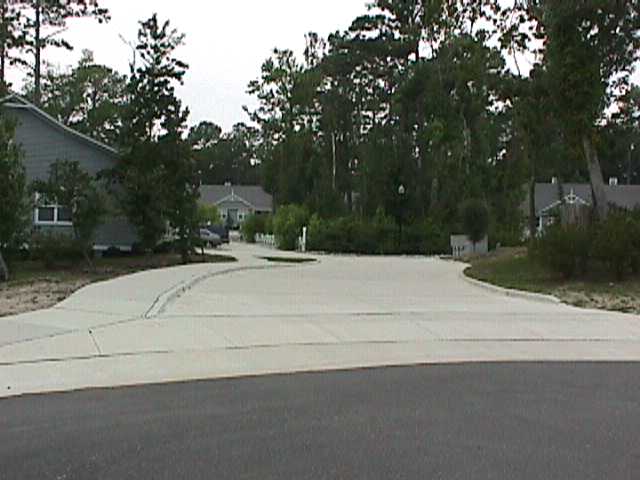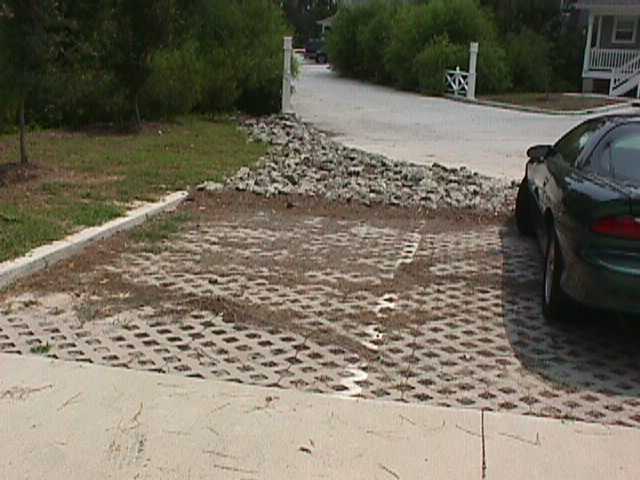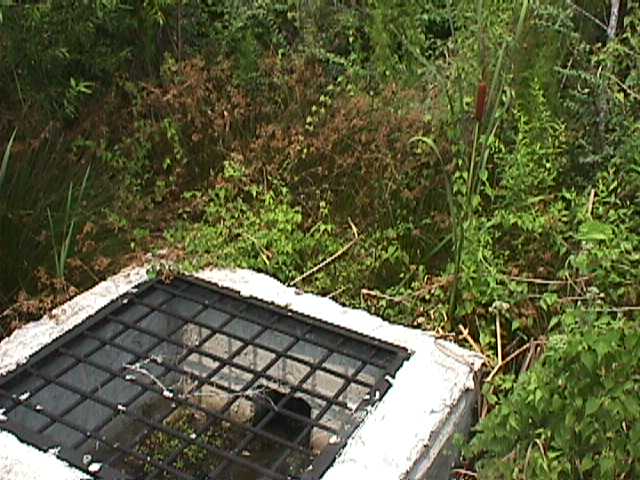
The
Hewletts Run development, located off Pine Grove Drive just north of Hewletts
Creek, was planned and constructed with the aim of managing stormwater
runoff in an environmentally sensitive and proactive way. The picture below
was taken facing west into the project area. Three of the four unit clusters
are visible. A natural wetland that was retained to manage stormwater lies
in the center of the project. Note the large amount of natural vegetation
in the project area; multi-level vegetation helps soften the impact of
rainfall, limits erosion, and reduces direct runoff. Note also that there
is very little lawn; grass is an unnatural groundcover in this region,
and typical residential lawns do a poor job of managing stormwater runoff
compared to natural vegetation. Note also that the paved areas are sloped
to direct runoff toward the central wetland.
The picture below shows the central wetland area
more closely. Note that the wetland border is surrounded by riprap that
slows sheet flow of runoff from the paved area, so that there is more time
for water to soak into the ground in the wetland itself. Note also the
large trees that were kept in place and the thickness of the vegetation.
Vegetation helps manage stormwater by intercepting rainfall and by lowering
the volume of standing water through evapotranspiration. The vegetation
also provides habitat for wildlife, especially birds, which residents find
attractive. Finally, vegetation helps baffle noises.

This picture of a parking area in Hewletts Run shows several
practices that reduce the impact of stormwater runoff. The developer has
installed porous materials for parking spaces instead of solid concrete.
Riprap is used to retard the flow of stormwater between the parking area
and the central wetland. The graded surfaces are sloped toward the wetland
area.

Return to Ponds Project
The photograph below shows the outlet
drain from the central wetland to a small tributary of Hewletts Creek.
Under most conditions the drain creates a pool of standing water, which
fosters the growth of aquatic insects and small fishes that eat mosquito
larvae. The drain also helps trap sediment and debris that would otherwise
wash into Hewletts Creek. Note the cattail plant, a typical wetland species,
growing next to the right corner of the drain.
Effects of a natural wetland on stormwater quality:
A UNCW Honors and Directed Independent Study project by Christopher Cruvant and Kelly Saunders evaluated the effects of the wetland in the center of the Hewletts Run development on water quality and related parameters during the period fall, 1997 - spring, 1999. They measured various water quality parameters in the wetland and downstream of it during rainy and dry periods to compare effects and evaluate the effectiveness of the wetland in retaining pollutants. They also looked at the effects on the wetland vegetation of increased water retention after the outlet drain was installed.
Findings:
Fecal Coliform Bacteria indicate contamination by fecal material. In this area, pets and wild animals are the most likely sources of this contaminant. Hewletts Creek itself is designated "SA" waters, which means it should support shellfishing and should have coliform levels below 14 Colony Forming Units (CFU) per 100 ml, so it is important that fecal contamination be minimized in this watershed. Fecal coliform levels averaged 103 CFU/100 ml in the central wetland at the outlet drain, declined to an average of 20.5 CFU/100 ml in the flow just downstream of that, but were higher again (average = 103 CFU/100 ml) in Hewletts Creek itself downstream of the project. Thus, the wetland apparently intercepts some fecal contamination but other sources in the Hewletts Creek drainage cause problems.
Turbidity is a measure of light scattering by particulate matter in the water and is associated with soil erosion and other problems. Turbidity levels above 30 NTU are considered poor; levels in water in the Hewletts Run area never exceeded 0.2 NTU, so the wetland does a good job of treating this water quality problem.
Dissolved oxygen supports aerobic life forms and ideally should occur at concentrations above 5.0 mg/l. However, swamp and wetland waters often have much lower levels and life forms living in those habitats often are adapted to low oxygen levels. Dissolved oxygen levels at the outlet drain in the Hewletts Run wetland were usually very low (< 0.25 mg/l) somewhat higher in the wetland area between the outlet drain and Hewletts Creek (averaging 0.1 - 2.5 mg/l, depending on conditions) and higher in Hewletts Creek itself (averaging 4.6 mg/l). These findings are as expected.
Orthophosphate is one form of the major plant nutrient, phosphorus, and occurs in solution and adsorbed onto particles. Levels of orthophosphate were highest at the outlet drain (averaging about 95 ug P/l) and were lower downstream (averaging less than 22 ug P/l in the wetland below the outlet drain and about 7 ug P/l in Hewletts Creek itself). These findings indicate that the wetlands did a good job of managing phosphorus loading to downstream waters.
Sediment phosphorus levels are an indicator of the accumulation of this nutrient. Sediment phosphorus levels were low throughout the project area, but were higher in the wetland (average value = 20 ug P/g sediment) than in areas downstream (average value = 12 ug P/g sediment in Hewletts Creek). These findings indicate that phosphorus loading has not yet become a major problem for the Hewletts Run drainage basin and that the wetland is retaining phosphorus well.
Total nitrogen is a measure of the quantity of this major plant nutrient that is biologically available. Levels of total nitrogen increased between the outlet drain (average = approximately 700 ug N/l) and Hewletts Creek itself (average = 1300 ug N/l), indicating that Hewletts Run was not a real source of this nutrient to the Creek. Nitrogen compounds are often very soluble and mobile, so other upstream sources may easily account for these observations. The levels in Hewletts Creek are not outrageously high, but probably reflect human impacts in the basin anyway.
Vegetation in the Hewletts Run project recovered very strongly from the damage caused by Hurricanes Bertha and Fran and from the effects of construction, which all took place in the period 1996-1997. A variety of woody and herbaceous plants fill the wetland areas in the project, yielding essentially 100% ground cover and multiple layers of vegetation. This situation is ideal for managing the impacts of rain and for encouraging a healthy wetland community. The plants provide habitat and food for wildlife, buffer water levels, take up nutrients, and secrete compounds that may inhibit growth of harmful bacteria.
Return to Ponds Project